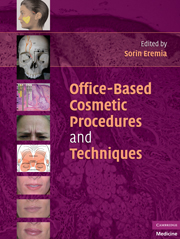Book contents
- Frontmatter
- Contents
- PREFACE
- CONTRIBUTORS
- PART ONE ANATOMY AND THE AGING PROCESS
- PART TWO ANESTHESIA AND SEDATION FOR OFFICE COSMETIC PROCEDURES
- Chap. 2 LOCAL ANESTHETICS
- Chap. 3 THE CONCEPT OF TUMESCENT ANESTHESIA
- Chap. 4 NERVE BLOCKS
- Chap. 5 TOPICAL ANESTHESIA
- PART THREE FILLERS AND NEUROTOXINS
- PART FOUR COSMETIC APPLICATIONS OF LIGHT, RADIOFREQUENCY, AND ULTRASOUND ENERGY
- PART FIVE OTHER PROCEDURES
- INDEX
- References
Chap. 2 - LOCAL ANESTHETICS
from PART TWO - ANESTHESIA AND SEDATION FOR OFFICE COSMETIC PROCEDURES
Published online by Cambridge University Press: 06 July 2010
- Frontmatter
- Contents
- PREFACE
- CONTRIBUTORS
- PART ONE ANATOMY AND THE AGING PROCESS
- PART TWO ANESTHESIA AND SEDATION FOR OFFICE COSMETIC PROCEDURES
- Chap. 2 LOCAL ANESTHETICS
- Chap. 3 THE CONCEPT OF TUMESCENT ANESTHESIA
- Chap. 4 NERVE BLOCKS
- Chap. 5 TOPICAL ANESTHESIA
- PART THREE FILLERS AND NEUROTOXINS
- PART FOUR COSMETIC APPLICATIONS OF LIGHT, RADIOFREQUENCY, AND ULTRASOUND ENERGY
- PART FIVE OTHER PROCEDURES
- INDEX
- References
Summary
BASICS OF LOCAL ANESTHESIA
Mechanism of Action
Local anesthetics block Na+ influx during depolarization of the nerve cell membrane. The result is the blockade of the action potential and subsequent anesthesia.
Order of Blockade
The blockade proceeds from pain through temperature, touch, pressure, vibration, propioception, and motor function:
First affected are the small, unmyelinated C-type nerve fibers (which transmit pain and temperature).
Last affected are the largest, myelinated A-type fibers (which transmit pressure sensations and motor fibers).
Patients may have anesthesia but still feel pressure and may have the ability to move because the A-type fibers are unblocked.
Composition
Anesthetics are weak organic bases that exist in two forms:
The ionized form is an active form that blocks nerve conduction. The ionized form is water-soluable, therefore allowing injection. At physiologic pH, 80% is in the ionized form.
The nonionized form is the lipid-soluable form that facilitates diffusion into tissues and nerve cell membranes.
Chemical Structure
The chemical structure has three components:
The aromatic portion is usually composed of a benzene ring (lipophilic).
The intermediate chain is either an ester or an amide linkage (determines class).
The amine is hydrophilic (water solubility).
Lipid solubility is important because it enables diffusion through the lipophilic nerve membrane. Lipophilicity is directly related to potency.
Duration of Anesthesia
Duration is directly related to the degree of protein binding of the anesthetic receptors along the nerve cell membrane (determined by amine structure).
- Type
- Chapter
- Information
- Office-Based Cosmetic Procedures and Techniques , pp. 9 - 14Publisher: Cambridge University PressPrint publication year: 2010



